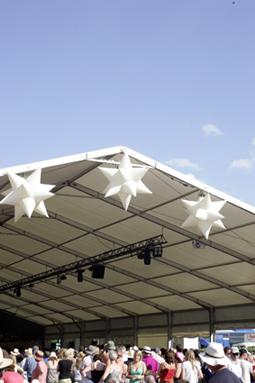Search
Rychard Carrington reports on Cambridge Folk Festival. Part 1: The Experience – Cherry Hinton Hall, 26-29 July 2007

Such impressions are subtle, but I'm inclined to trust that I'm not merely projecting my own aspirations in seeing in the festival a sense of community, of shared positive values, that renders it something much more valuable than a commercial entertainment binge for the liberal middle class. Although the socialist aesthetic politics of the folk revival of the 1950s now seem quaintly puritanical, and the ‘Woodstock nation', ‘free festival as alternative society' counter-culture of the hippie era a romantic lost cause, there remains, I think, a sense of a progressive alternative to the mainstream. Joan Baez declared that since Bush's election a large audience was turning to her as a ‘safe haven'; one can extend this vision to the folk culture as a whole. Cambridge Folk Festival being so large and thriving, this culture, temporarily, seems hearteningly strong. This feeling is most evident when a main stage performer expresses a political sentiment and receives heartfelt applause from all around. But the sense of benign values informing a festival culture that is both socially progressive and tasteful can be seen in the ethnic food stalls, the Friends of the Earth and Unison stands, the colourful clothing and imaginative games on sale, the homeopathy and massage available, the creative children's entertainments, the hot'n'spicy cider. All of the above blend well with a musical diet, which, although very eclectic, seems, to be Leavisite for a moment, essentially life-affirming, whether the form be joyous comedy, political protest or empathetic tales of birth, copulation and death, traditional or contemporary. What the diverse performers have in common is a sincere passion for music as a brilliant expression of all that is good in human life and society.
The festival has been criticised for moving away from traditional music and the folk club scene: a fair point, methinks, but the criticism is well answered by the sheer spirit of all the performances - from Martin Simpson to Toots And The Maytals to Jenna Reid to Ruthie Foster to Fanfare Ciocarlia. These are not poseurs, not informed by values of commerce or fashion - attitudes and talent blend together. It's a spirit of which the festival should be proud, and with which the folk movement does well to identify. Inevitably some of the character of smaller festivals is absent, but a large-scale festival compliments these and generates its own sense of significance and celebration.
Of course festival-goers can get into the spirit of the festival, and into the great music on offer, to varying extents. With tickets expensive and not easy to come by (they sell out within hours), it amazes me how many people treat the festival as merely an environment for a nice picnic with friends, and some of the best folk music in the world as aural background for their newspaper reading. When such people are inside the tents, blocking the way and disturbing the quiet for those who've actually come to listen to the music, I feel angry. Little social gatherings pretty oblivious to both the music and other festival-goers add considerably to the festival's biggest problem: congestion. Numbers of tickets having been increased a few years ago, moving from tent to tent can be a slight ordeal, and standing in a squashed crowd between acts can be wearisome (journalists, whose vantage point is a reserved seated area - or the backstage bar - are unlikely to pick up on these aspects in their reviews). Realistically there's no chance of returning to smaller crowds, when demand for tickets is so high, but please can the festival at least not get any bigger (and please continue without large video screens either - that just ain't folk).
It is, then, the broad character of the festival which determines its success. The forty-third festival was not a departure but another edition of a unique annual occasion, that delivered its promise as reliably as ever. The standard of the actual music at the festival has been so consistently high over the years that one can take it for granted. One can't compare each year on the strength of the line-ups: by the end of every festival, one is always convinced that the quality could not have been higher. There's so much that one can't appreciate it all - even if one could be in each of the three tents at once - one has to tune out with a drink and a spot in the sun to revive one's musical appetite. A performance has to be savoured in the moment: no time for it be absorbed afterwards, as another performance, probably equally outstanding, swiftly follows.
But to run through the acts, nevertheless, because so many really were superb, go to the next review, Cambridge Folk Festival Part 2: Band-by-Band.
Writer: Rychard Carrington
Photo: Claire Borley www.claireborley.co.uk